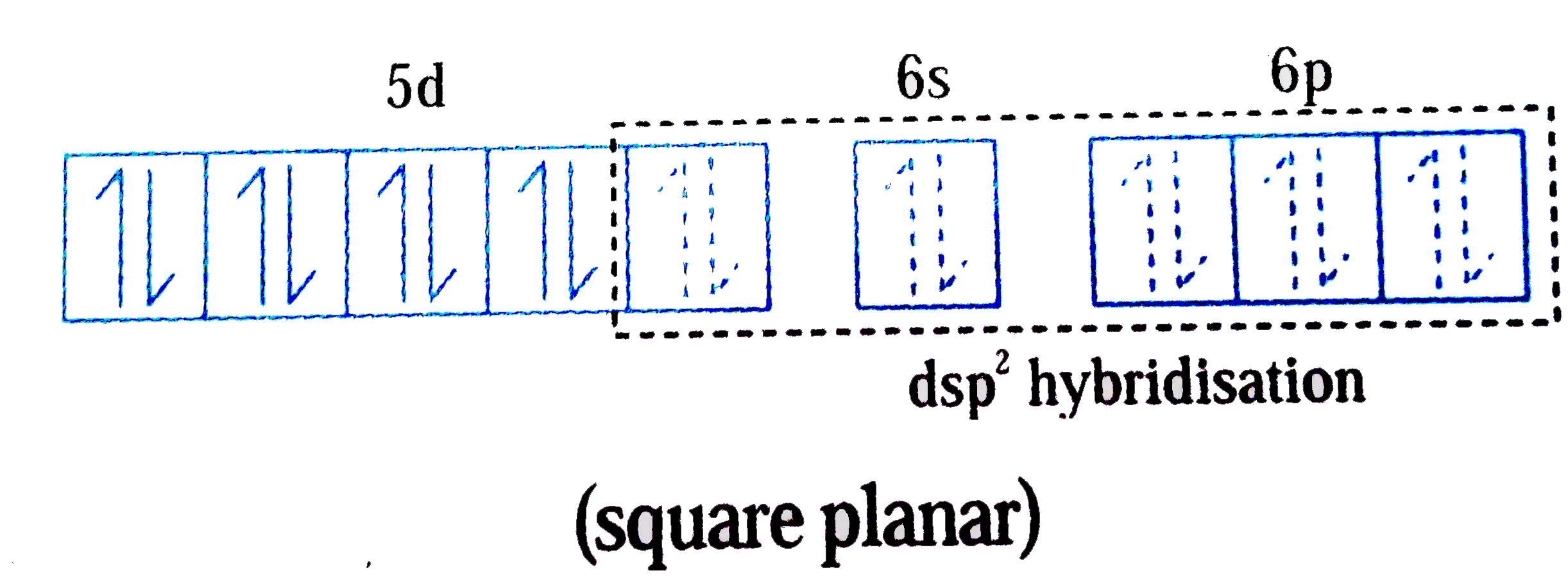Co2+(aq)+SCN−(aq)→complex(X).
Ni2+(aq)+DimethylglyoximeNH4OH−−−−→Complex(Y).
The coordination number of cobalt and nickel in complexes X and Y are four.
The geometry of complexes (X) and (Y) are respectively :
tetrahedral and sqaure planar.
both tetrahedral.
square planer and tetrahedral
both square planer.
(A),X=[Co(SCN)4]2−,
cobalt is in +2 oxidation state and SCN− is weak field ligand . So, [Co(SCN)4]2−:

[Ni(dmg)2]: Nickel is in +2 oxidation state and dmg is chelating ligand. So,
[Ni(dmg)2]:

Topper's Solved these Questions
- COORDINATION COMPLEXESBook:NARAYNAChapter:COORDINATION COMPLEXESExercise:Comprehension-4
Explore 2 Videos
- COORDINATION COMPLEXESBook:NARAYNAChapter:COORDINATION COMPLEXESExercise:Comprehension-5
Explore 2 Videos
- COORDINATION COMPLEXESBook:NARAYNAChapter:COORDINATION COMPLEXESExercise:Comprehension-2
Explore 3 Videos
- CO-ORDINATE COMPOUNDS Book:NARAYNAChapter:CO-ORDINATE COMPOUNDS Exercise:Exercise-4
Explore 60 Videos
- D - BLOCK ELEMENTSBook:NARAYNAChapter:D - BLOCK ELEMENTSExercise:CHECK YOUR GRASP
Explore 7 Videos
Similar Questions
Co2+(aq.)+SCN−(aq.)→Complex(X)
Ni2+(aq.)+DimethylglyoximeNH4OH−−−−→Complex(Y).
The coordination number of cobalt and nickel in complexes X and Y is four.
The geometry of complexes (X) and (Y) are respectively :
View SolutionCo2+(aq)+SCN−(aq)→complex(X).
Ni2+(aq)+DimethylglyoximeNH4OH−−−−→Complex(Y).
The coordination number of cobalt and nickel in complexes X and Y are four.
The geometry of complexes (X) and (Y) are respectively :
View Solution
Knowledge Check
Co2+(aq)+SCN−(aq)→complex(X).
Ni2+(aq)+DimethylglyoximeNH4OH−−−−→Complex(Y).
The coordination number of cobalt and nickel in complexes X and Y are four.
The IUPAC names of the complexes (X) and (Y) are respectively.Atetrahiocyanato-S-cobalt (II) and bis(dimethylglyoximate) nickel(II).Btetrathiocyanato-S-cobaltate (II) and bis(dimethylglyoximato) nickel (II).Ctetrathiocyanato-S-cobaltate (II) and bis(dimethylglyoximato) nickelate(II).Dtetrathiocyanato-S-cobaltate (II) and bis(dimethylglyoximato) nickel(II).Co2+(aq)+SCN−(aq)→complex(X).
Ni2+(aq)+DimethylglyoximeNH4OH−−−−→Complex(Y).
The coordination number of cobalt and nickel in complexes X and Y are four.
The IUPAC names of the complexes (X) and (Y) are respectively.Atetrahiocyanato-S-cobalt (II) and bis(dimethylglyoximate) nickel(II).Btetrathiocyanato-S-cobaltate (II) and bis(dimethylglyoximato) nickel (II).Ctetrathiocyanato-S-cobaltate (II) and bis(dimethylglyoximato) nickelate(II).Dtetrathiocyanato-S-cobaltate (II) and bis(dimethylglyoximato) nickel(II).Co2+(aq.)+SCN−(aq.)→Complex(X)
Ni2+(aq.)+DimethylglyoximeNH4OH−−−−→Complex(Y)
The coordination number of cobalt and nickel in complexes X and Y are four.
The IUPAC name of the complexes (X) and (Y) are respectively :Atetrathiocyanoato-S-cobalt(II) and bis(dimethylglyoximate) nickel (II).Btetrathiocyanoato-S-cobaltate(II) and bis(dimethylglyoximato) nickel (II).Ctetrathiocyanoato-S-cobaltate(II) and bis(dimethylglyoximato) nickelate (II).Dtetrathiocyanoato-S-cobaltate(III) and bis(dimethylglyoximato) nickel (II).
Co2+(aq)+SCN−(aq)→Complex (X)
Ni2+(aq.)+DimethylglyoximeNH4OH−−−−→Complex (Y).
The coordination number of cobalt and nickel in compleses X and Y are four.
The IUPAC names of the complexes (X) and (Y) are respectively :
View SolutionCo2+(aq.)+SCN−(aq.)→Complex(X)
Ni2+(aq.)+DimethylglyoximeNH4OH−−−−→Complex(Y).
The coordination number of cobalt and nickel in complexes X and Y is four.
The IUPAC name of the complexes (X) and (Y) are respectively:
View SolutionCo2+(aq)+SCN−(aq)→complex(X).
Ni2+(aq)+DimethylglyoximeNH4OH−−−−→Complex(Y).
The coordination number of cobalt and nickel in complexes X and Y are four.
Select the correct statement for the complexes (X) and (Y).
View SolutionCo2+(aq)+SCN−(aq)→complex(X).
Ni2+(aq)+DimethylglyoximeNH4OH−−−−→Complex(Y).
The coordination number of cobalt and nickel in complexes X and Y are four.
Select the correct statement for the complexes (X) and (Y).
View SolutionCo2+(aq)+SCN−(aq)→complex(X).
Ni2+(aq)+DimethylglyoximeNH4OH−−−−→Complex(Y).
The coordination number of cobalt and nickel in complexes X and Y are four.
The IUPAC names of the complexes (X) and (Y) are respectively.
View Solution

